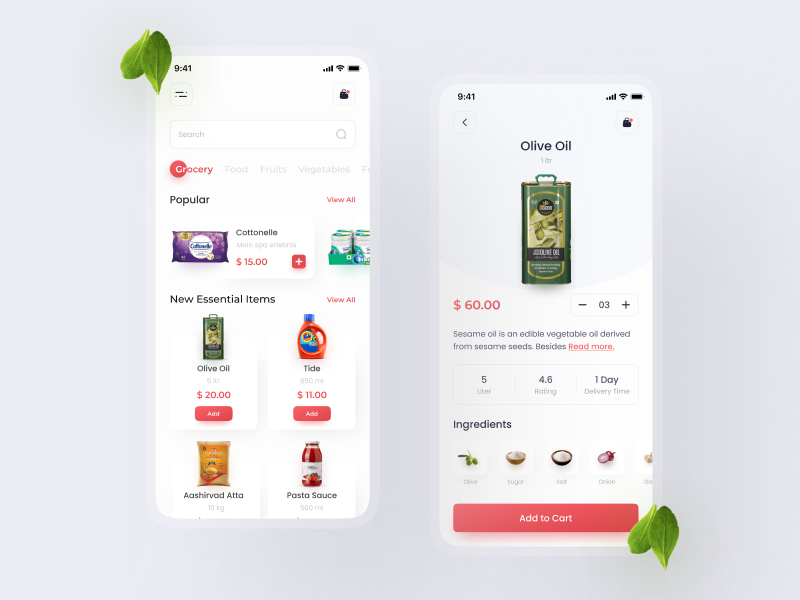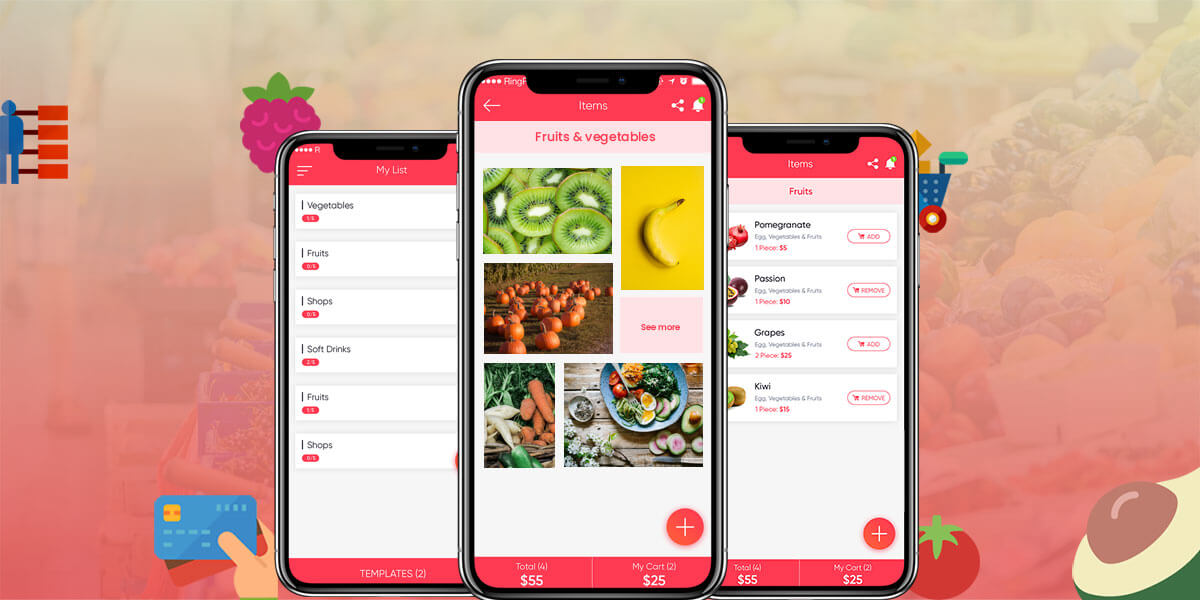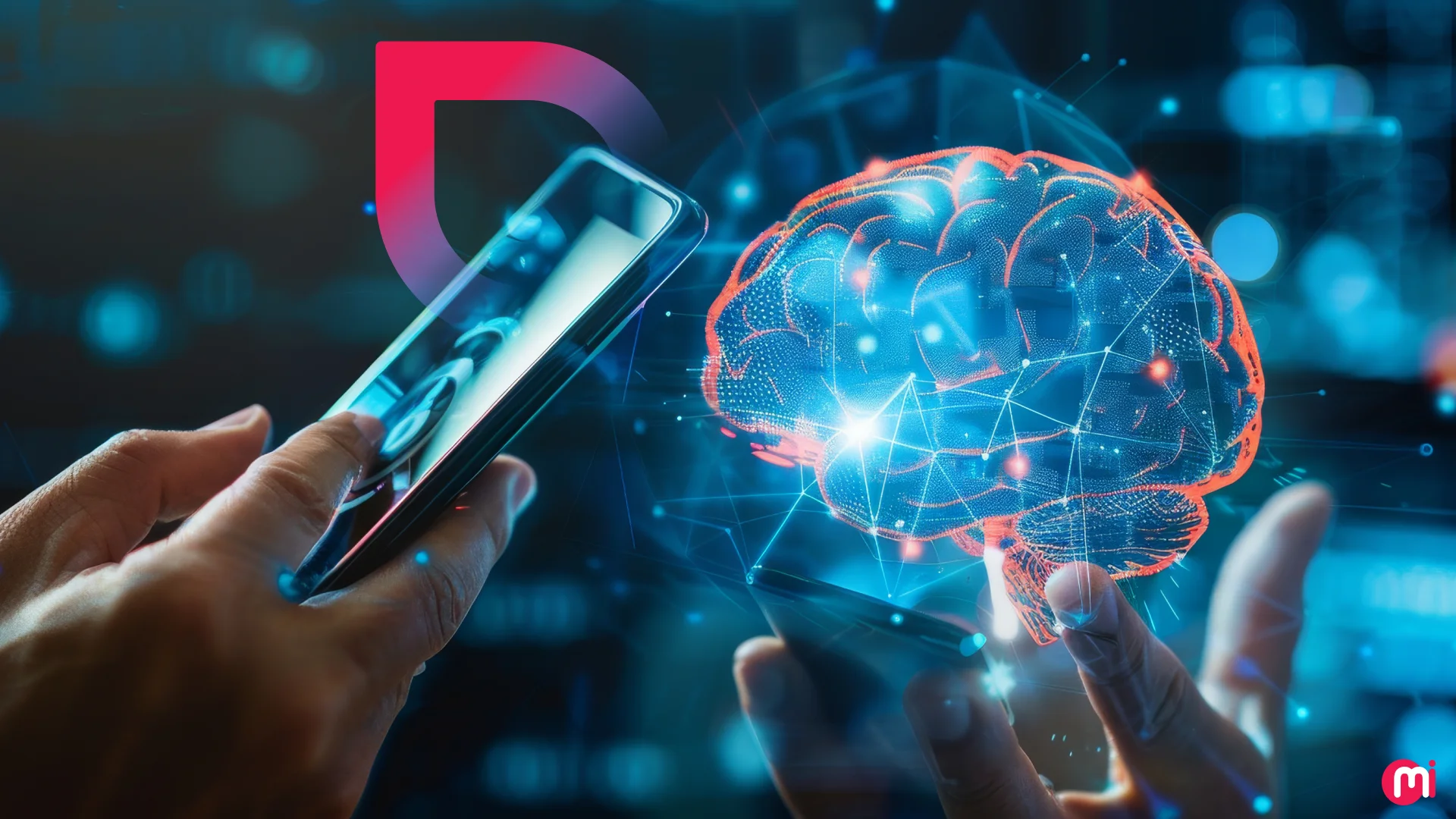Grocery Delivery App Development: Key Features and Cost Estimation
- Mobile
- October 29, 2018
Who doesn’t love shopping? Most people specifically the females have a knack for picking up items.
And when it comes to grocery items, they make sure that they have every essential item in their pantry and household.
Now, with the arrival of digital transformation and the upsurge for on-demand mobile applications, online grocery delivery apps are occupying the center stage.
What’s more exciting is you don’t have to visit a traditional brick-and-mortar store or even a supermarket to choose the groceries, which can become tedious if you have a busy schedule ahead. In fact, even the statistics and numbers are predicting a bright future ahead for the grocery delivery apps.
According to CNBC, online grocery sales is set to hike at and expected to grab 20% of the market by 2025.
One of the other stats suggests that the usage of grocery apps would increase by 50% by the end of this year 2018.
This is the hour when you need to strategically change your business tactics to reach out to more potential customers.
With companies including Walmart, Instacart, Amazon Fresh etc. already making their mark in grocery delivery app businesses, you cannot shy away for long from following the technological route to deliver best-in-class services.
Types of Grocery Shopping Apps
Usually, you would come across three types of grocery apps that are popular among the customers. They are:
The E-Commerce Grocery Delivery App
The most popular e-commerce apps such as Amazon, Flipkart, etc. offer the widest range of grocery items in various user locations.
They also allow the customers to select a suitable delivery time according to their convenience.
Individual Grocery Apps
There are some mobile apps, which are particularly dedicated to offering grocery products only. Examples include BigBasket, Grofers, etc.
They enhance the shopping experience of the consumers and offer services such as grocery list, grocery IQ, and delivery.
Supermarket or in-store based Grocery App
As the sales of online grocery is moving up, even supermarkets like Costco, and Publix, etc. have started offering the various grocery items through the app.
They combine the functionalities of both personalized and e-commerce grocery apps with push notifications and beacon technology when the customer is near to the store.
Key Benefits Grocery Delivery App Offer to the Business and Users
The grocery apps have proved to be a boon for both the business owners as well as the users.
Let’s have a glance at some of the pros of building such apps.
Available 24×7 Days
The grocery apps are readily accessible all throughout the year, which means the customers can shop anytime and from anywhere around the world.
Time Saving
Grocery apps can save a lot of your precious time as you don’t have to visit the store personally to pick the items of necessity.
Just place the order to be rightly delivered at the preferred location.
Online Order Tracking
The customers can now trace their order online and know the estimated time of delivery.
Get to know the Customer Reviews
The apps allow customers to share their valuable feedback and ratings, which indeed helps in improving the services.
Attractive Discounts and Offers
Ever since the grocery apps have increased in numbers, there has been a steady competition and this creates a venerable opportunity for the user to get attractive offers and deals.
Easy Payment Options
The customers also get the facility of the convenient payment options wherein they can choose to pay online or opt for the Cash on Delivery option.
Widest Range of Brands and Products
With grocery delivery app, the consumers can have the luxury of choosing from the widest range of products and brands according to their budget estimate.
Managing the Inventory Stock
The apps also help the business owners to keep an eye on their inventory and manage it accordingly as per the demand of the consumers in the market.
Read also: Grocery Business are Opting for Mobile Apps: Let’s Find out the Reasons
Significant Features of Grocery App
It is imperative to be familiar with what vital features need to be included in the grocery app so that it can stand apart in the crowd.
Features Essential from the User Panel Prospective

Registration and User Profile
The first significant part is the registration page where the user would have register his account using his email id and phone number.
Once the account gets registered, he must proceed to create a personal user profile in which he has to fill some other details such as a residential address, age, etc.
This would actually prepare a personal data of the user helpful to target him while sending notifications.
Search and Browse Products
This is the most important feature of the grocery app allowing the customer to search for a particular product and also helping him to browse through the different category of items.
Add to Cart
The grocery app should have the Add to Cart option where the customer can add a product of his choice but wants to buy later.
Managing the Items
The customers can check and manage the items before making the payment so that he is sure that nothing has been added extra into the list or left behind.
Payment Gateway
Payment gateway integration becomes an essential part for most of the on-demand apps including grocery letting the customer pay easily using the different options according to his convenience.
You can integrate PayPal or Stripe or use e-wallet options such as Paytm etc.
Users can also pay using their debit or credit cards, internet banking and choose the COD option.
Read also: Tips to Integrate Paytm Payment Gateway
Scheduling the Delivery and Tracing Order
Once you have made the payment, it’s time for the convenient scheduled delivery.
In addition, you can also track the status of the order and know when it’s going to be delivered.
Push Notifications
Push Notification is another must-have feature in the grocery app.
You can send notifications about the best offers and discounts, attractive coupons, etc. to your loyal customers to increase the sales and traffic on the app.
Ratings and Reviews
Your customer’s reviews and ratings are very important for your app to flourish better.
The customers sending their feedback about their experiences about using the app will help you to better the services and plan strategies further.
Customer Support
You should not forget to include the customer support panel for helping out customers in choosing the right product that they are looking for.
You can integrate the 24×7 online chat options besides the phone and email communication.
In order to further enhance the experience, look to implement the chatbot, which is a virtual assistant, answering questions in real-time.
Admin Panel Features to Implement
Dashboard
This is a complete information center where the admin can manage all orders received from the customers and make his services quick and on the go.
Inventory Management
This feature is important from the admin prospect as it helps him to manage the huge stock of inventory conveniently.
The admin would be able to handle all the orders appropriately. In addition, you can add more segments here such as managing the payment and customers.
Assigning the Orders
Once the order is received and confirmed, the store managers can assign a task to the delivery persons to deliver the items at the place mentioned.
Real-time Analytics
The real-time analytics help you keep the track record of your esteemed customers and also extract the vital data when required.
Based on the information gathered, you can frame your business plan and strategy on how to bolster the experience of the users.
You can also have a view of the most successful offers and discounts that customers loved to streamline the growth process.
Grocery App Features for Delivery Panel
Geo-Location Services
Implementing the geo-location services is pivotal as it will assist the delivery person to easily track the location of the customer.
You can integrate Google or Apple Map with the GPS facility.
Read also: Benefits of Having Geolocation in Your Mobile App
In-app chat or calling
It allows the delivery person or the driver to directly contact the customer through phone or online chat basis if he is unable to trace the address.
Accept or Reject the Delivery Request
The driver can accept or reject the delivery of the grocery items if the location of the customer is too far and it does not fall within the stipulated distance of free delivery.
Delivery Notification
It notifies the store manager that an order has been requested for the delivery along with the order number.
Developing a Strong Backend Server
Just forgot to mention about this indispensable element when developing the grocery app.
Since you have to store mammoth data of thousands of customers, you need to create a strong backend development for this purpose.
You can go for Cassandra and PostgreSQL for building the server-side cloud database. But the choice of frameworks such as Python and JavaScript isn’t a bad choice either.
The App Designing
The next important player in the discussion is app designing. Yes, we are talking about the User Interface and User Experience, which shouldn’t be taken lightly.
Since you are developing a grocery app, the importance of the product image and its description becomes all the more significant.
Another important aspect is to well define each of the categories. Make sure that the barcode scanning is properly visible.
You can provide the option of zoom in the picture of the item to ensure customers about what they are buying. The price should be mentioned clearly.
Read also: Importance of UI/UX Design in Mobile App Development
The Cost of Developing a Grocery Delivery App
When we talk about the cost of grocery apps, several factors come into play including the platform, the features, the app development team, pricing model and others etc.
However, roughly, the grocery app would cost you in the region of about $14k to 18k on an estimate. However, much would depend on the App Development Company you opt for.

Finally Wrapping Up
We have already discussed earlier that the future prospect of the online grocery industry is in flourishing hands and as the time goes ahead, the customer base of this on-demand app would scale higher.
People looking for more luxury and comfort, the grocery apps will also be boosting the market economy in the future.
So, don’t create any second thoughts in mind and approach the master craftsmen in app development to create a grocery app within your budget estimate.
FAQs About Grocery Delivery App Development
The cost to develop a grocery delivery app depends on features, the complexity of the design, location of a developer, and other requirements. However, on average, the grocery app may cost you between $14,000 to $18,000.
The time to develop a grocery delivery app depends on many elements like experience level of developer, app functionality, testing, and deployment. The grocery delivery app development can take between 550 to 700 hours.
A grocery delivery app can make money in many ways like commission, delivery fee, convenience charges, paid listings, running ads, etc.
You can hire a developer for the grocery delivery app by searching on Google, LinkedIn, Toptal, or Clutch. But, the best way is to hire a developer from reputed development firms like Mindinventory.













